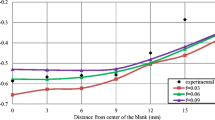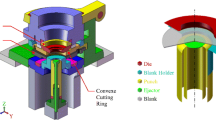Abstract
In order to study the secondary deep drawing process of a cup-shaped part from a theoretical perspective. In this paper, a stress analysis model for the secondary deep drawing process of a cup-shaped part is represented, and the parameter effects of the blank holder radius, die radius, and punch radius are fully considered in this model. The radial stress model is a piecewise function taking the punch displacement as the independent variable, and the punch force calculation method is then obtained. Through comparison, the calculated result is in good agreement with the finite element simulation result, shows a better calculated accuracy than the analysis model for neglecting the effect of radius parameters, and is also similar to the actual experiment. Therefore, it can be concluded that the stress analysis model has sufficient accuracy to represent the secondary deep drawing process of a cup-shaped part which will improve the research situation caused by a serious shortage of theoretical work.









Similar content being viewed by others
References
Leu DK (1999) Limiting drawing ratio for plastic instability of the cup-drawing process. J Mater Process Technol 86:168–176
Verma RK, Chandra S (2006) An improved model for predicting limiting drawing ratio. J Mater Process Technol 172:218–224
Narayanasamy R, Ponalagusamy R, Raghuraman S (2008) The effect of strain rate sensitivity on theoretical prediction of limiting draw ratio for cylindrical cup drawing process. Mater Des 29:884–890
Leu DK, Wu JY (2004) A simplified approach to estimate limiting drawing ratio and maximum drawing load in cup drawing. journal of engineering materials and technology-transactions of the asme 126:116–122
Blala H, Lang LH, Li L, Sherkatghanad E, Alexandrov S (2020) Investigation on the effect of blank holder gap in the hydroforming of cylindrical cups, made of fiber metal laminate. Int J Adv Manuf Technol 108:2727–2740
Liu XJ, Gao JC, Li C, Qin J, Ding HF (2020) Investigation on precision warm hydroforming with independent circumferential pressure of high-performance aluminum alloy parts with special-shaped bottom. Int J Adv Manuf Technol 109:201–213
Malekipour E, Heidary H, Majd NS, Mazdak S, Sharifi E (2020) Effect of resonant frequency variation on the ultrasonically assisted deep drawing process: numerical and experimental study. Int J Adv Manuf Technol 106:2243–2264
Zhou BJ, Xu YC, Zhang ZC (2020) Research on the selection principle of upper sheet in double-layer sheets hydroforming. Int J Adv Manuf Technol 109:1663–1669
Tamasco CM, Rais-Rohani M, Buijk A (2013) Coupled finite element simulation and optimization of single- and multi-stage sheet-forming processes. Eng Optim 45:357–373
Kang BS, Ku TW (2011) Experimental study on multi-stage deep drawing for rectangular cup with high aspect ratio. Int J Adv Manuf Technol 53:131–143
Liu P, Ku T-W, Kang B-S (2013) A study on initial blank design to minimize earing in multi-stage deep drawing process for rectangular cup using high strength steel material. In: 3rd International Conference on Advances in Materials Manufacturing (ICAMMP 2012). Beihai, China, pp 1971–1975
Parsa MH, Yamaguchi K, Takakura N (2001) Redrawing analysis of aluminum-stainless-steel laminated sheet using FEM simulations and experiments. Int J Mech Sci 43:2331–2347
Kim HK, Hong SK (2007) FEM-based optimum design of multi-stage deep drawing process of molybdenum sheet. J Mater Process Technol 184:354–362
Chan LC, Fu MW, Li N, Lu J (2010) FEA-aided design of multi-stage drawing process and tooling for production of a miniature sheet metal component. Int J Adv Manuf Technol 46:993–1000
Li WT, Fu MW, Wang JL, Meng B (2016) Grain size effect on multi-stage micro deep drawing of micro cup with domed bottom. Int J Precis Eng Manuf 17:765–773
Park JH, Kim JB, Park K (2015) Fully coupled numerical analysis of high frequency induction heating and warm sheet metal forming. Steel Research International 86:877–885
Sonis P, Reddy NV, Lal GK (2003) On multistage deep drawing of axisymmetric components. Journal of Manufacturing Science and Engineering-Transactions of the Asme 125:352–362
Fazli A, Arezoo B (2014) An analytical method for prediction of limiting drawing ratio for redrawing stages of axisymmetric deep drawn components. Journal of Manufacturing Science and Engineering-Transactions of the Asme 136:02101201–02101210
Guo ZF, Tang WC (2016) Stress analysis of cup-shaped parts in secondary deep drawing. Jilin Daxue Xuebao (Gongxueban)/Journal of Jilin University (Engineering and Technology Edition) 46:494–499 (in Chinese)
Hu SG, Chen HZ, Li DS, Wang XF (2009) Engineering analysis of sheet metal cold press forming process. second ed. ed. beijing, Beijing University of Aeronautics and Astronautics Press
Thiagarajan G, Kadambi AV, Robert S, Johnson CF (2015) Experimental and finite element analysis of doubly reinforced concrete slabs subjected to blast loads. International Journal of Impact Engineering 75:162–173
Pereira LF, Weerheijm J, Sluys LJ (2016) A new rate-dependent stress-based nonlocal damage model to simulate dynamic tensile failure of quasi-brittle materials. International Journal of Impact Engineering 94:83–95
Wang C (2010) The numerical simulation and optimum design on open kettles cover. Zhejiang University of Technology, Dissertation
Nam J, Han KS (2000) Finite element analysis of deep drawing and ironing process in the steel D & I canmaking. ISIJ Int 40:1223–1229
Availability of data and material
Not applicable
Code availability
Not applicable
Funding
The authors would like to thank the National Key Research and Development Program of China (2019YFB1312101) for the continuous funding support.
Author information
Authors and Affiliations
Contributions
Zhefeng Guo designed the algorithm and wrote the original draft; Li Liang and Qingyi Men revised the manuscript; Xiangyu Kang and Junli A checked the manuscript and made some modifications. All the authors have read and agreed to the published version of the manuscript.
Corresponding author
Ethics declarations
Conflict of interest
The authors declare no competing interests.
Additional information
Publisher’s note
Springer Nature remains neutral with regard to jurisdictional claims in published maps and institutional affiliations.
Rights and permissions
About this article
Cite this article
Guo, Z., Men, Q., Kang, X. et al. A stress analysis model of a cup-shaped part in a secondary deep drawing process. Int J Adv Manuf Technol 116, 473–486 (2021). https://doi.org/10.1007/s00170-021-07239-4
Received:
Accepted:
Published:
Issue Date:
DOI: https://doi.org/10.1007/s00170-021-07239-4




